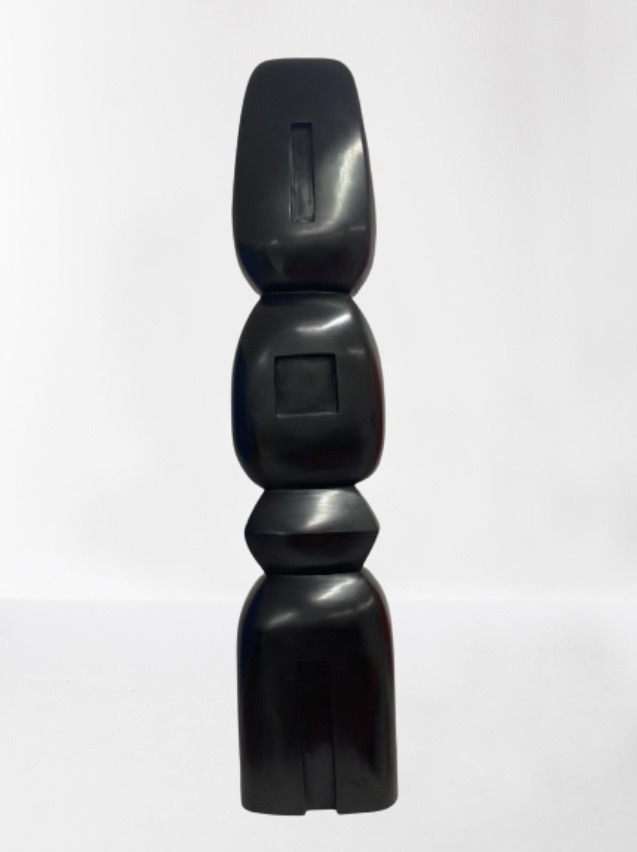
Title: STILE CADAQUES OU PERSONNAGE
Material: BRONZE 25RRT
Size: 131 X 27 X 18 CM,
ASK FOR PRICE
-988 2/8
FRANÇOIS STAHLY, 1911 - 2006
François Stahly was born in Constance, Germany in 1911, and grew up in neighboring Switzerland. He attended the Art Academy in Zurich, but, desiring to go beyond the formalism of Bauhaus principles that were taught there, decided in 1931 to continue his studies in Paris at the atelier of Charles Malfray at the Académie Ranson, where he encountered a fertile artistic climate. He befriended the sculptor Etienne-Martin, married in 1934 Claude Favre and in 1936 joined a group of young artists called Témoignage (Witness). Adrift during the war, Stahly lost all of his work prior to 1940. He reconnected with his friend Etienne –Martin in a spirit of mutual exchange and the two collaborated on various projects that helped them through the difficult post-war years.
In 1949 Stahly settled in Meudon. Soon he developed a personal idiom with forms reminiscent of tree roots. ‘The root’, art critic Pierre Descargues notes, ‘does not grow in an environment which encourages its untrammelled growth (…)[it] is confronted by the weight of the soil which slows down, deviates and, from small distortions to major deviations, resembles the difficult environment of creation.’ From the baroque, aquatic roots that celebrate the sensuality of the vegetal world, eventually another direction in Stahly’s work emerged in which simple, basic forms were grouped together in monumental compositions.
Stahly showed his work in prestigious galleries (such as Galerie Darthea Speyer), but, uncomfortable with the role of commerce in art choose not to be linked with any gallery in particular. Instead he focused on creating monumental sculptures for public places. While trying to avoid the pitfalls of working on commission, Stahly set out to assert an independent place for sculpture in an architectural setting and introduced the idea of fluidity and movement to sculptures related to architecture. In the sixties and early seventies he completed a series of major sculptural pieces on commission, both in the United States and Europe, such as Le Labyrinthe at the University of Jussieu, L’Eté de la Foret at the estate of Nelson Rockefeller in Tarrytown, N.Y. and the Jardin-Labyrinthe at the Empire State Plaza in Albany, N.Y.
In 1960 Stahly temporarily settled in the United States to teach at the University of Berkeley in California and at Washington University in Seattle, followed by an art residency at Stanford University in 1964-65. This allowed him to experiment with teamwork and draw into question the axiom that artistic expression is intrinsically individual. He considered true art to be universal, so what better way to tap into this professed universality than to work collectively. Idealistic by nature, he founded upon his return to France a collective workshop in Crestet (Vaucluse). After an interlude following his wife’s death in 1973 Stahly got back on track in 1975 when he remarried the sculptress Parvine Curie. Together they turned Crestet once more into a place of apprenticeship until it was finally sold to Ministry of Culture in 1985 and turned into a Contemporary Art Centre. After that Stahly and Curie settled permanently in Meudon while traveling extensively. Stahly worked until 1996. During the last decade of his career he made personal work: drawings as well as small and medium sized sculptures. He died in 2006.
Stahly received various awards and distinctions, notably the Gold Medal of the Milan Triennial (1953), the Prize of the Sao Paolo Biennale (1957), the Grand Prize of the Biennale of Tokyo (1965), the Grand Prix des Beaux-Arts de la Ville de Paris (1972) and the Grand Prix National de la Sculpture (1979). In 1992 he was elected member of the Académie des Beaux-Arts.
His work is included in many important private and public collections, such as Tate Gallery in London, the Museum of Modern Art in Tokyo, the National Museum of Modern Art in Paris, and the Museum of Art and History in Meudon.

